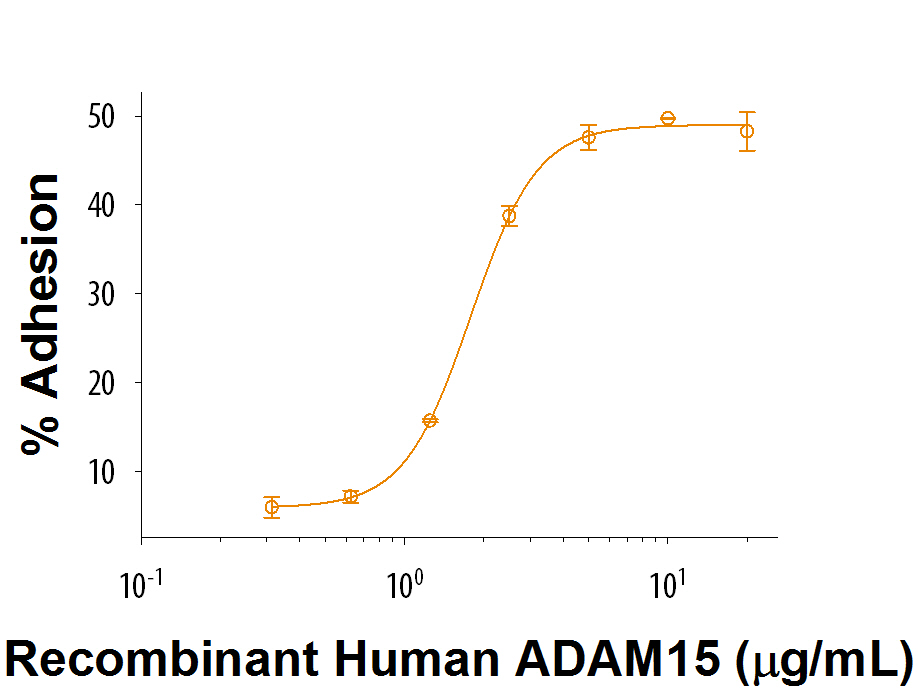Recombinant Human ADAM15 Protein, CF Summary
Product Specifications
Asp207-Ser693 with a C-terminal 10-His tag
Analysis
Product Datasheets
Carrier Free
CF stands for Carrier Free (CF). We typically add Bovine Serum Albumin (BSA) as a carrier protein to our recombinant proteins. Adding a carrier protein enhances protein stability, increases shelf-life, and allows the recombinant protein to be stored at a more dilute concentration. The carrier free version does not contain BSA.
In general, we advise purchasing the recombinant protein with BSA for use in cell or tissue culture, or as an ELISA standard. In contrast, the carrier free protein is recommended for applications, in which the presence of BSA could interfere.
9234-AD
| Formulation | Lyophilized from a 0.2 μm filtered solution in MES and NaCl. |
| Reconstitution | Reconstitute at 500 μg/mL in water. |
| Shipping | The product is shipped at ambient temperature. Upon receipt, store it immediately at the temperature recommended below. |
| Stability & Storage: | Use a manual defrost freezer and avoid repeated freeze-thaw cycles.
|
Scientific Data
 View Larger
View Larger
Immobilized Recombinant Human ADAM15 (Catalog # 9234-AD) supports the adhesion of Jurkat human acute T cell leukemia cells. The ED50 for this effect is 0.5-3 μg/mL.
Reconstitution Calculator
Background: ADAM15
A disintegrin and metalloproteinase 15 (ADAM15), also known as MDC15 and Metargin, is an approximately 110 kDa transmembrane member of the M12B family of peptidases (1). Human ADAM15 is synthesized with a 189 amino acid (aa) propeptide that contains a cysteine switch motif. The 75 kDa activated form of human ADAM15 (after removal of the propeptide) consists of a 490 aa extracellular domain (ECD) with a peptidase, disintegrin, cysteine-rich, and EGF-like domain followed by a 21 aa transmembrane segment and a 146 aa cytoplasmic domain (2). Within the ECD, human ADAM15 shares 85% aa sequence identity with mouse and rat ADAM15. Alternative splicing generates multiple additional isoforms with various deletions or substitutions in the cytoplasmic domain, deletion in the propeptide and peptidase domains, or truncation at the beginning of the EGF-like domain (3, 4). ADAM15 is widely expressed, including on colonic epithelial cells, smooth muscle cells, vascular endothelial cells, and it is upregulated during chronic inflammation and tumor progression (5-8). It is also expressed on spermatocytes where both propeptide and the protease domain are cleaved during spermatocyte maturation (9, 10). ADAM15 promotes endothelial permeability, T cell adhesion, MMP-9 production and activation, and tumor cell metastasis (6, 8, 11, 12). It binds to Integrin alpha V beta 3 (13) and mediates the proteolytic shedding of cell surface
N-Cadherin, E-Cadherin, MICB, CD23/Fc epsilon RII, and FGF R2 (IIb) (6, 7, 14-16).
- Edwards, D.R. et al. (2008) Mol. Aspects Med. 29:258.
- Kratzschmar, J. et al. (1996) J. Biol. Chem. 271:4593.
- Kleino, I. et al. (2009) J. Cell. Biochem. 108:877.
- Kleino, I. et al. (2007) BMC Mol. Biol. 8:90.
- Mosnier, J.F. et al. (2006) Lab. Invest. 86:1064.
- Najy, A.J. et al. (2008) Cancer Res. 68:1092.
- Duan, X. et al. (2013) Mol. Med. Rep. 7:991.
- Dong, D.D. et al. (2015) Oncol. Rep. 34:2451.
- Pasten-Hidalgo, K. et al. (2008) Reproduction 136:41.
- Pasten, K. et al. (2014) Reproduction 148:623.
- Sun, C. et al. (2010) Cardiovasc. Res. 87:348.
- Charrier, L. et al. (2007) J. Biol. Chem. 282:16948.
- Zhang, X.P. et al. (1998) J. Biol. Chem. 273:7345.
- Najy, A.J. et al. (2008) J. Biol. Chem. 283:18393.
- Fourie, A.M. et al. (2003) J. Biol. Chem. 278:30469.
- Maretzky, T. et al. (2009) Biochem. J. 420:105.
FAQs
No product specific FAQs exist for this product, however you may
View all Proteins and Enzyme FAQsReviews for Recombinant Human ADAM15 Protein, CF
Average Rating: 4 (Based on 1 Review)
Have you used Recombinant Human ADAM15 Protein, CF?
Submit a review and receive an Amazon gift card.
$25/€18/£15/$25CAN/¥75 Yuan/¥1250 Yen for a review with an image
$10/€7/£6/$10 CAD/¥70 Yuan/¥1110 Yen for a review without an image
Filter by:

